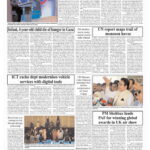By Dr Ali Farhan Razi
Diabetes mellitus, particularly Type 2 diabetes, has emerged as a formidable public health challenge in Pakistan. With an alarming increase in prevalence over recent years, the disease now affects a significant portion of the adult population, placing Pakistan among the countries with the highest diabetes burdens globally.
Prevalence and Global Standing
According to the International Diabetes Federation (IDF), as of 2021, approximately 33 million adults in Pakistan are living with diabetes, marking a staggering 70% increase since 2019. This surge positions Pakistan as the country with the third-highest number of individuals with diabetes worldwide, following China and India . The national prevalence rate stands at 26.7%, the highest globally, indicating that more than one in four Pakistani adults is affected by the disease .   

Age and Demographic Distribution
Diabetes in Pakistan predominantly affects adults aged 20 to 79 years. The prevalence increases with age, with individuals over 40 years being particularly susceptible. Studies have shown that urban populations exhibit higher prevalence rates compared to rural areas, likely due to lifestyle factors such as sedentary behavior and dietary habits . 
Undiagnosed Cases and Impaired Glucose Tolerance
A concerning aspect of the diabetes epidemic in Pakistan is the high number of undiagnosed cases. Approximately 26.9% of adults living with diabetes are unaware of their condition, which increases the risk of complications and hinders effective management . Additionally, around 11 million adults have impaired glucose tolerance (IGT), placing them at high risk of developing Type 2 diabetes .   
Mortality and Complications
In 2021, diabetes was responsible for an estimated 400,000 deaths in Pakistan, the highest number in the Middle East and North Africa region . The disease is associated with severe complications, including cardiovascular diseases, kidney failure, blindness, and lower-limb amputations, which significantly impact the quality of life and healthcare costs.  
Contributing Factors
Several factors contribute to the rising prevalence of diabetes in Pakistan:
• Lifestyle Changes: Urbanization has led to decreased physical activity and increased consumption of processed foods. 
• Obesity: A significant risk factor, with a growing number of individuals being overweight or obese.
• Genetic Predisposition: A family history of diabetes increases susceptibility.
• Lack of Awareness: Limited knowledge about the disease and its risk factors hampers prevention efforts. 
Prevention and Management Strategies
Addressing the diabetes crisis in Pakistan requires a multifaceted approach:
• Public Awareness Campaigns: Educating the population about risk factors, symptoms, and the importance of early detection.
• Lifestyle Interventions: Promoting healthy eating habits and regular physical activity to prevent onset.
• Healthcare Infrastructure: Strengthening primary healthcare services to facilitate early diagnosis and management.
• Policy Measures: Implementing regulations to reduce the consumption of sugary beverages and unhealthy foods.
• Research and Surveillance: Conducting regular surveys to monitor prevalence and effectiveness of interventions.
Conclusion
The escalating prevalence of diabetes in Pakistan is a pressing public health concern that necessitates immediate and sustained action. Through comprehensive strategies encompassing education, lifestyle modification, healthcare improvements, and policy reforms, it is possible to curb the tide of this epidemic and improve the health outcomes for millions of Pakistanis.















